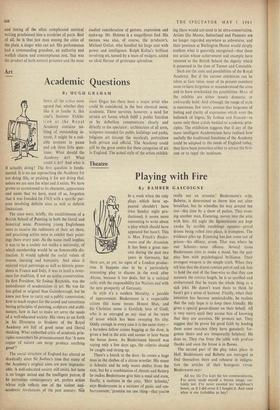Art
Academic Questions
By HUGH GRAHAM
The aims were, briefly, the establishment of a British School of Painting in both the literal and historical sense. Promising young Englishmen were to receive the rudiments of their art there, and practising artists were to exhibit their paint- ings there every year. As the name itself implies, it was to be a society not unlike a university, of which membership would be an honourable dis- tinction. It would uphold the social values of reason, learning and humanity. And since it enjoyed royal patronage as well as historic prece- dents in France and Italy, it was to instil a rever- ence for tradition, if not an active conservatism. Its first President, Sir Joshua Reynolds, was the embodiment of academicism in art. He was far less gifted or original than Gainsborough, but he knew just how to carry out a public commission, how to teach respect for the sound and sometimes boring principles of painting, sculpture and archi- tecture, how in fact to make art serve the needs of a well-educated society. His views as set forth in his Discourse to Students of the Royal Academy are full of good sense and liberal thinking. What embattled critic of academic prin- ciples remembers his pronouncement that 'A mere copier of nature can never produce anything great'?
The social structure of England has altered so drastically since Sir Joshua's time that many of the Academy's original aims are now impractic- able. A well-educated society still exists, but taste is no longer united and the intelligent patron, if he patronises contemporary art, prefers artists whose style reflects one of the violent anti- academic revolutions of the past century. NOt since Degas has there been a major artist who could be considered, in the best classical sense, academic. There survives, however, a need for certain art forms which fulfil a public function or by definition communicate clearly and directly to the spectator : architecture of all sorts, sculpture intended for public buildings and parks, religious art (except the mystical), portraiture both private and official. The Academy could still be the great centre for these categories of art in England. The actual style of the artists exhibit- ing there would not need to be ultra-conservative. Artists like Moore, Sutherland and Pasmore are no longer regarded anywhere as subversive, and their presence at Burlington House would simply confirm what is generally recognised—that these are artists whose achievement and example have restored to the British School the dignity which it possessed in the time of Turner and Constable.
Such are the aims and possibilities of the Royal Academy. But if the current exhibition can be taken at face value, most of its present members seem to have forgotten or misunderstood the aims and to have overlooked the possibilities. Most of the exhibits are either tamely domestic or awkwardly bold. And although the range of style is enormous, few works possess that largeness of feeling and clarity of expression which were the hallmark of ingres, Sir Joshua and Poussin—to name only three artists wedded to academic prin- ciples. The exhibition suggests that if any of the more intelligent Academicians have realised how usefully the traditional functions of the Academy could be adapted to the needs of England today, they have been powerless either to attract the first- rate or to repel the mediocre.






































 Previous page
Previous page